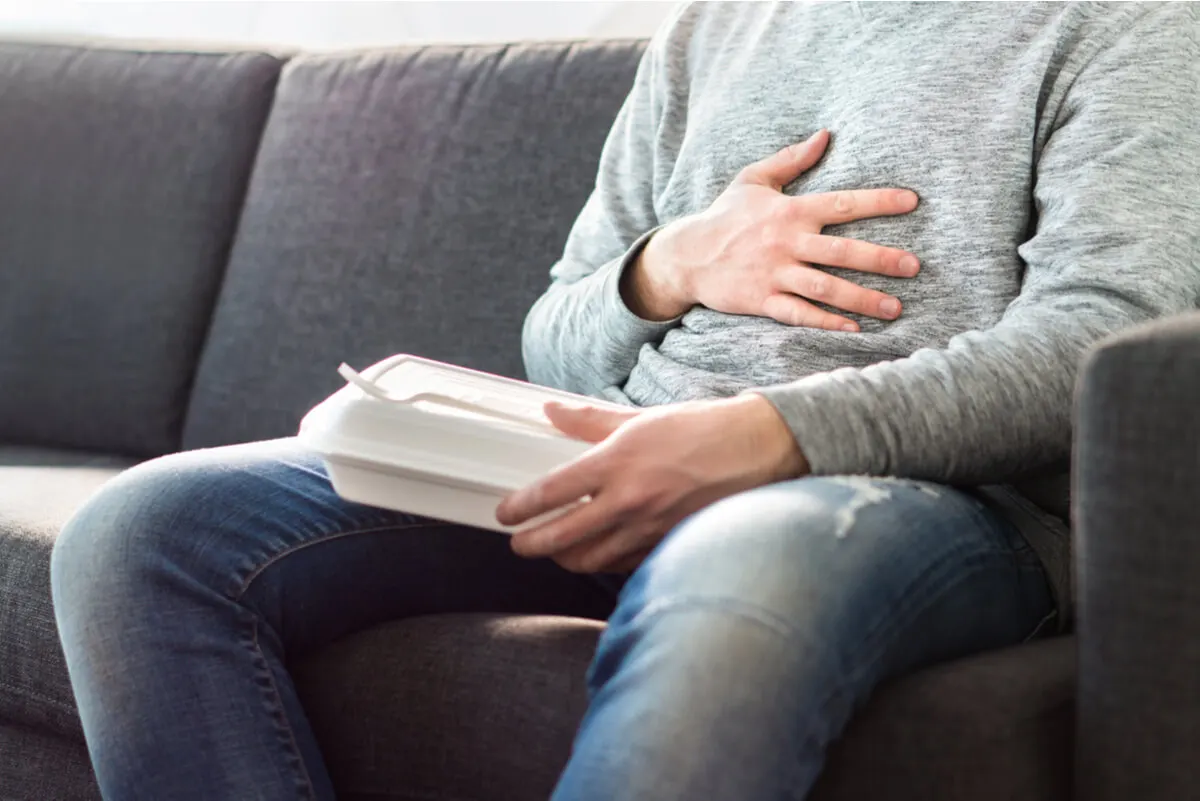Gastroesophageal Reflux Disease: Everything You Need to Know


Written and verified by the doctor Leonardo Biolatto
Gastroesophageal reflux disease is a common condition identified by the acronym GERD. It’s a condition that’s influenced by many factors, such as diet, weight, and even stress. Because of these triggers, its prevalence has increased markedly in recent years.
Almost everyone has experienced acid reflux at some time in their lives. However, GERD isn’t a one-time occurrence, but goes beyond that. In this article, we’ll explain everything you need to know about this condition and how to treat it.
What is gastroesophageal reflux disease?
Gastroesophageal reflux disease is when the acid content present in the stomach frequently moves up into the esophagus. As we noted in the introduction, almost everyone has experienced reflux at some time.
The difference between the disease and occasional reflux is that, in this condition, it happens at least once or twice a week. According to a review article published in the journal Acta Gastroenterologica Latinoamericana, the prevalence is between 10 and 20% in Western countries. In Asian countries, this prevalence is much lower, perhaps due to factors related to their type of diet.
Acid reflux occurs because the lower esophageal sphincter is weakened. This sphincter is actually a group of muscles that control the passage of food from the esophagus to the stomach. When this happens and acid reaches the esophagus repeatedly, the mucosa that lines it is damaged.
In a study published in Anales del Sistema Sanitario de Navarra, they state that one of the most frequent complications is Barret’s esophagus. This is a condition that produces a series of precancerous changes in the esophageal mucosa.
Another possible complication is an esophageal ulcer. The acid can continuously damage the mucosa, causing this lesion to form, which bleeds and complicates digestion.

What are the risk factors for GERD?
As mentioned at the beginning, this condition is multifactorial. That is to say, its development is influenced by numerous factors. First of all, obesity is one of the most associated factors, as well as diet. People who eat abundantly, especially at night, are more likely to suffer from it.
This is especially the case if their meals are rich in fat. The same happens among those who abuse alcohol or coffee, since they’re substances that increase the secretion of acid in the stomach. Smoking has also been recognized as a risk factor.
According to a study published in Farmacia Profesional, there are other important factors. For example, carbonated beverages, physical exercise, and even sleeping in certain postures. Similarly, stress and pregnancy are important triggers of this condition.
What are the symptoms?
The symptoms of gastroesophageal reflux disease can be very annoying and disabling. Most people who have this condition explain that they suffer from a burning sensation that rises up into the throat. It usually appears at night or after meals.
This is because, when lying down, it’s easier for the stomach contents to back up into the esophagus. Another typical symptom is chest pain, as well as the sensation of having a lump in the throat.
In some people, if the disease progresses, it’s common to find difficulty in swallowing or breathing. In fact, aphonia and throat clearing are other common signs of this condition.
We think you may also enjoy reading this article: Gastroesophageal Reflux Disease (GERD): Symptoms and Treatment
How is gastroesophageal reflux disease diagnosed?
The diagnosis of gastroesophageal reflux disease is complex. First, it’s usually based on the symptoms. In most cases, pharmacological treatment is first available to check the patient’s progress.
Even so, after a few weeks, it’s recommended that the esophagus be explored by means of complementary tests. This is to observe if there’s still reflux and if there are lesions or complications derived from it. Below, we’ll explain the main tests that doctors usually perform.
An endoscopy for gastroesophageal reflux disease
An endoscopy is a test that consists of introducing a thin, flexible tube through a body orifice. In this case, it’s done through the throat. This tube has a light and an integrated camera.
An endoscopy makes it possible to observe the esophagus and check for inflammation or lesions. Biopsies of esophageal tissue can even be taken with the same instrument and analyzed later.
An esophageal manometry
Esophageal manometry is a test that measures the pressure and contractions that occur along the esophagus. In this way, the strength of the muscles is observed, which may indicate a disturbance of the lower esophageal sphincter.
24-hour pH measurement (pHmetry)
To perform this test, a probe is inserted through the nose into the end of the esophagus or into the stomach. This test can be used to see if reflux episodes occur and how long they last by measuring pH variations.
Treatments for gastroesophageal reflux disease
Fortunately, advances in medicine have allowed gastroesophageal reflux disease to be treated in a number of ways. The first is to try to change certain habits and try specific medications that we will discuss in the next section.
In cases where these measures do not work, there are also a number of more aggressive options that can resolve the condition definitively. In the first place, we find fundoplication.
This is a surgical technique that consists of wrapping the upper part of the stomach over the final part of the esophagus. Thus, the sphincter is engulfed, and more pressure is exerted, helping to prevent the acid content from rising again.
Another technique is the placement of the LINX device. According to a study published in International ECOS of Surgery, this is a method that has proven to be effective. It is a kind of magnetic ring that selectively closes the junction between the esophagus and the stomach. It prevents reflux, but allows food to pass through.
Like this article? You may also like to read: How To Calm Your Gastroesophageal Reflux Symptoms
Treatments and recommendations at home
Before resorting to surgery, it’s important to modify certain habits to prevent gastroesophageal reflux disease. First of all, it is essential to reduce body weight (at least in those people in whom obesity is one of the influential factors).
When eating, the key is to remain seated or standing for about three hours to favor the descent of the liquid by gravity. The same can be done if reflux occurs during the night. Many people use pillows to elevate the trunk. In addition, it’s essential to quit smoking.

Over-the-counter medications for gastroesophageal reflux disease
There are medications commonly used for gastroesophageal reflux disease that don’t require a prescription. For example, there are antacids such as sodium bicarbonate. However, these substances shouldn’t be abused, as they don’t actually solve the problem.
The most commonly used drugs are those that block the production of acid in the stomach. Firstly, there are those that act by inhibiting the proton pump, such as omeprazole. There are also those that act on the histamine receptors in the stomach, although these are usually the second option.
The problem is that these types of drugs, when taken over a prolonged period of time, are associated with serious side effects. For example, they’re associated with an increased risk of cancer, as explained in a study published in the Revista Colombiana de Gastroenterología.
Prescription drugs
Some drugs that also act as proton pump inhibitors do require a prescription. For example, there are esomeprazole or lansoprazole. Others, such as baclofen, act by strengthening the lower esophageal sphincter. They‘re usually more potent drugs or with a higher risk of side effects.
GERD and a change in habits
Gastroesophageal reflux disease is a common condition that’s influenced by many factors. To prevent it, it’s important to be aware that obesity and eating habits strongly influence its development.
In addition, it’s necessary always to consult a doctor in case you notice any of the symptoms. Acid can cause lesions on the esophagus and lead to serious complications.
All cited sources were thoroughly reviewed by our team to ensure their quality, reliability, currency, and validity. The bibliography of this article was considered reliable and of academic or scientific accuracy.
- Fajardo Ramos, Elizabeth, et al. “Factores asociados a la prevalencia de enfermedad por reflujo gastroesofágico en funcionarios de una universidad pública de Ibagué (Colombia).” Revista Salud Uninorte 33.3 (2017): 296-305.
- Katelaris, Peter, et al. “ERGE. Perspectiva mundial sobre la enfermedad por reflujo gastroesofágico.” Gastroenterol. latinoam 29.3 (2018): 123-146.
- DE ERGE, ESTABLECER EL DIAGNÓSTICO. “Guías clínicas de diagnóstico y tratamiento de enfermedad por reflujo gastroesofágico.” (2007).
- Castro, Francisco Hidalgo, Carlos Melgoza Ortiz, and Ramiro Hesiquio. “Funduplicatura tipo Nissen por vía laparoscópica en el tratamiento de la esofagitis por reflujo: análisis de 72 pacientes.” Cirujano General 24.3 (2002): 196-200.
- Reflujo gastroesofágico: Síntomas, diagnóstico y tratamiento. Clínica Universidad de Navarra. (n.d.). Retrieved October 20, 2020, from https://www.cun.es/enfermedades-tratamientos/enfermedades/reflujo-gastroesofagico
- Cardona-Ospina, J. A., Alejandro Medina-Morales, D., Rodríguez-Morales, A. J., & Machado-Alba, J. E. (2016). Efectos adversos a largo plazo de los inhibidores de la bomba de protones. Perspectiva desde la medicina basada en la evidencia Evidence Based Medicine Perspective on Long-Term Adverse Effects of Proton Pump Inhibitors.
- Gómez Aldana, Andrés José. “Guia de practica clinica: diagnóstico y tratamiento de la enfermedad por reflujo gastroesofágico.” Departamento de Medicina Interna.
- Enfermedad por reflujo gastroesofágico – Diagnóstico y tratamiento – Mayo Clinic. (n.d.). Retrieved October 20, 2020, from https://www.mayoclinic.org/es-es/diseases-conditions/gerd/diagnosis-treatment/drc-20361959
- Directivo Presidente Dra Elena López Gavito Vicepresidente Juan Roberto Torres Cisneros, C., Ocampo González, S., Antonio Loera Torres Tesorero Gustavo Olmos Ramírez, M., Pablo Pantoja Millán, J., Domínguez Rosado, I., Francisco Campos Campos Director Administrativo Lic Alejandro Cuellar Ramírez, S., & Angelos, P. (n.d.). ECOS Internacionales de Cirugía 2019 Segundo Vicepresidente Secretario General Coordinador del Comité Científico Director Ejecutivo AMCG Profesor Internacional Invitado. Retrieved from www.medigraphic.com
- Enfermedad por reflujo gastroesofágico. Clínica y tratamiento | Farmacia Profesional. (n.d.). Retrieved October 20, 2020, from https://www.elsevier.es/es-revista-farmacia-profesional-3-articulo-enfermedad-por-reflujo-gastroesofagico-clinica-13108592
- Enfermedad por reflujo gastroesofágico. (n.d.). Retrieved October 20, 2020, from http://scielo.isciii.es/scielo.php?script=sci_arttext&pid=S1137-66272003000300008
- Revisión sobre enfermedad por reflujo gastroesofágico (ERGE). (n.d.). Retrieved October 20, 2020, from https://actagastro.org/revision-sobre-enfermedad-por-reflujo-gastroesofagico-erge/
This text is provided for informational purposes only and does not replace consultation with a professional. If in doubt, consult your specialist.








